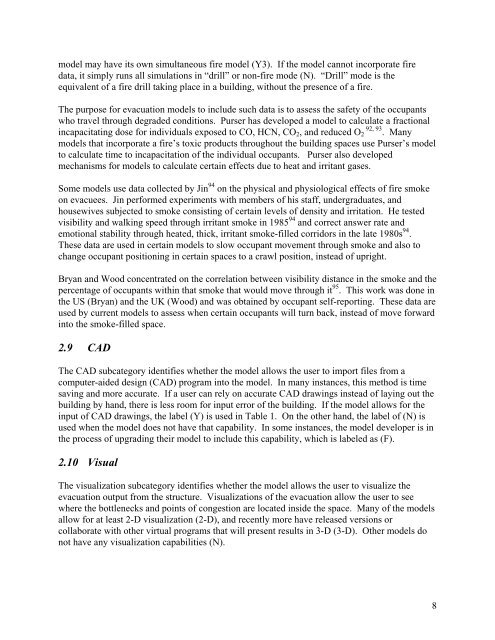A Review of Building Evacuation Models - NIST Virtual Library
A Review of Building Evacuation Models - NIST Virtual Library
A Review of Building Evacuation Models - NIST Virtual Library
Create successful ePaper yourself
Turn your PDF publications into a flip-book with our unique Google optimized e-Paper software.
model may have its own simultaneous fire model (Y3). If the model cannot incorporate fire<br />
data, it simply runs all simulations in “drill” or non-fire mode (N). “Drill” mode is the<br />
equivalent <strong>of</strong> a fire drill taking place in a building, without the presence <strong>of</strong> a fire.<br />
The purpose for evacuation models to include such data is to assess the safety <strong>of</strong> the occupants<br />
who travel through degraded conditions. Purser has developed a model to calculate a fractional<br />
incapacitating dose for individuals exposed to CO, HCN, CO 2 , and reduced O 2<br />
92, 93 . Many<br />
models that incorporate a fire’s toxic products throughout the building spaces use Purser’s model<br />
to calculate time to incapacitation <strong>of</strong> the individual occupants. Purser also developed<br />
mechanisms for models to calculate certain effects due to heat and irritant gases.<br />
Some models use data collected by Jin 94 on the physical and physiological effects <strong>of</strong> fire smoke<br />
on evacuees. Jin performed experiments with members <strong>of</strong> his staff, undergraduates, and<br />
housewives subjected to smoke consisting <strong>of</strong> certain levels <strong>of</strong> density and irritation. He tested<br />
visibility and walking speed through irritant smoke in 1985 94 and correct answer rate and<br />
emotional stability through heated, thick, irritant smoke-filled corridors in the late 1980s 94 .<br />
These data are used in certain models to slow occupant movement through smoke and also to<br />
change occupant positioning in certain spaces to a crawl position, instead <strong>of</strong> upright.<br />
Bryan and Wood concentrated on the correlation between visibility distance in the smoke and the<br />
percentage <strong>of</strong> occupants within that smoke that would move through it 95 . This work was done in<br />
the US (Bryan) and the UK (Wood) and was obtained by occupant self-reporting. These data are<br />
used by current models to assess when certain occupants will turn back, instead <strong>of</strong> move forward<br />
into the smoke-filled space.<br />
2.9 CAD<br />
The CAD subcategory identifies whether the model allows the user to import files from a<br />
computer-aided design (CAD) program into the model. In many instances, this method is time<br />
saving and more accurate. If a user can rely on accurate CAD drawings instead <strong>of</strong> laying out the<br />
building by hand, there is less room for input error <strong>of</strong> the building. If the model allows for the<br />
input <strong>of</strong> CAD drawings, the label (Y) is used in Table 1. On the other hand, the label <strong>of</strong> (N) is<br />
used when the model does not have that capability. In some instances, the model developer is in<br />
the process <strong>of</strong> upgrading their model to include this capability, which is labeled as (F).<br />
2.10 Visual<br />
The visualization subcategory identifies whether the model allows the user to visualize the<br />
evacuation output from the structure. Visualizations <strong>of</strong> the evacuation allow the user to see<br />
where the bottlenecks and points <strong>of</strong> congestion are located inside the space. Many <strong>of</strong> the models<br />
allow for at least 2-D visualization (2-D), and recently more have released versions or<br />
collaborate with other virtual programs that will present results in 3-D (3-D). Other models do<br />
not have any visualization capabilities (N).<br />
8
















